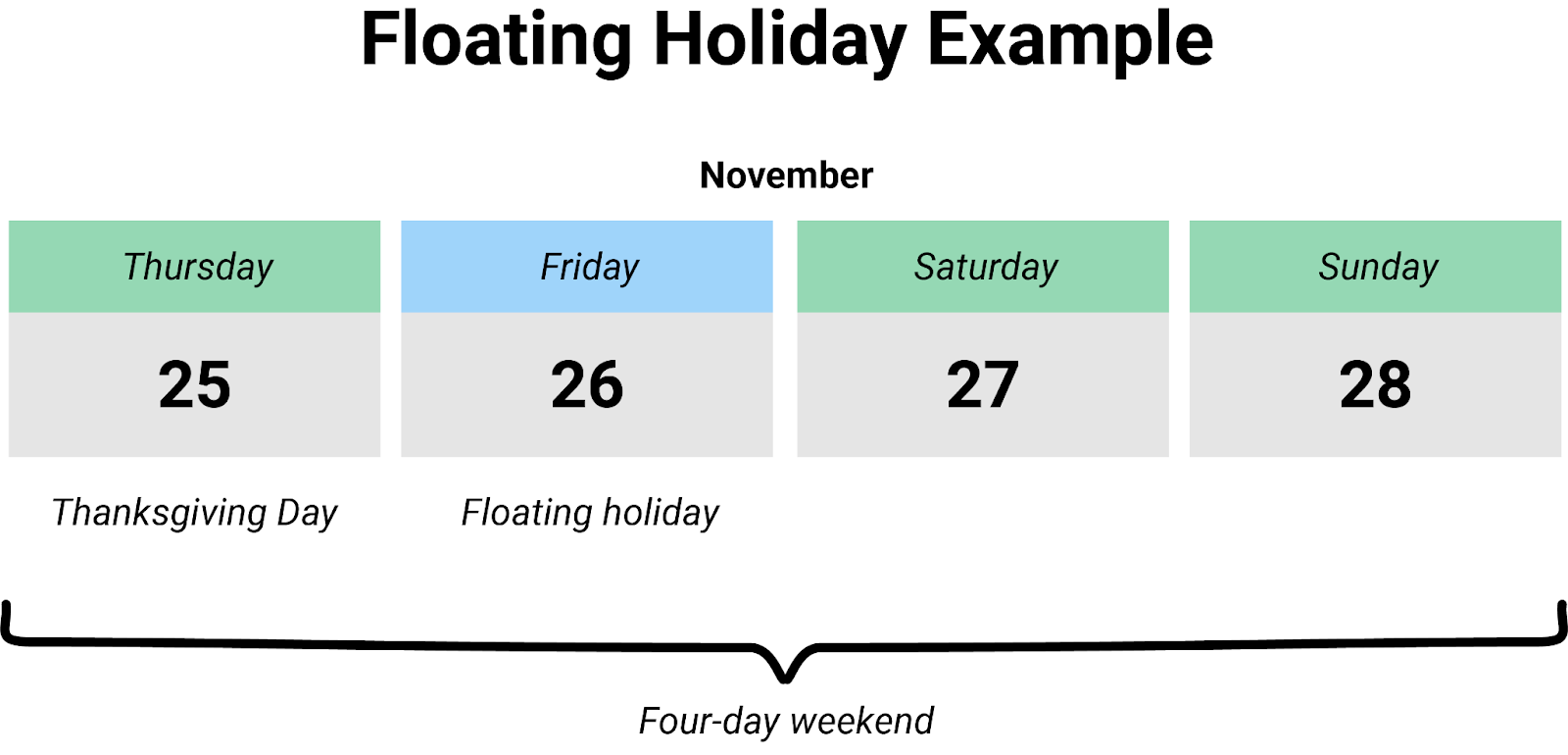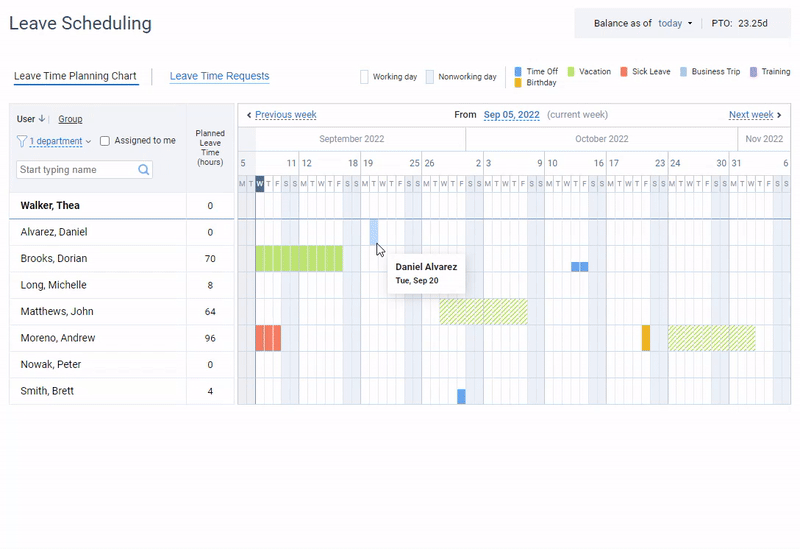Companies fight for talents by offering flexible schedules, sabbaticals and other employee perks and benefits. Floating holiday is one of the optional employee benefits that companies can offer and, at the same time, one of the most underappreciated and the least understood types of time off.
To help HR teams and managers understand the concept and get competitive advantage in talent attraction and retention, we’ve put together this guide. Read on to learn what are floating holidays, how to learn if your company could benefit from some and how to implement them into your company’s policy.

What Is a Floating Holiday?
Floating holidays (personal holidays, floating days off) are additional paid time off not tied to specific dates that employees can use as their personal days. A recent survey revealed that about 30% of organizations offer floating holidays, which are equal to no more than 2 days off that employees can take during the calendar year at their own discretion.
Neither FLSA, nor any other state or regional laws require employers to provide floating holidays. They are also not included in the paid holiday schedule of the company and serve as a means to boost employee morale and attract top talent.
What Is The Purpose of a Floating Holiday?
At first glance, the purpose and the benefits of floating holidays are not clear: why use more types of paid time off when employees can use their vacation PTO balances to have some personal time or deal with a family emergency, for example.
In reality, floating holidays is a company initiative to give employees more schedule flexibility and allow them to take a day off without wasting their PTO balance. The most common reasons for taking floating holidays include religious or cultural holidays, volunteering and extending a holiday leave. For example, if you have to work on the day after Thanksgiving, you can take a floating holiday to get a four-day weekend: Thursday, Friday, Saturday and Sunday.

What’s the Difference Between a Floating Holiday and Vacation Day?
Practically speaking, there’s not much difference between a floating holiday and a vacation day (PTO) as both of them are considered a paid day off from work.
Vacation days are usually either taken together as a block of time (you take 5 days off and have a week of vacation time, including weekends) or as a fraction of a day (let’s say, 2 hours off). In contrast, floating holidays require taking a full day off.
PTO is earned in small increments for each pay period and usually, unused PTO can be carried over from one calendar year to another. As for floating holidays, they are usually awarded when an employee joins an organization, they don’t accrue and expire at the end of the year.
And one more important difference between the two is that unused PTO is usually paid for, which is not true about floating holidays.
Benefits of Floating Holidays
Due to the difference between floating holidays and vacation days, we can highlight the following benefits of floating holidays:
- Improved work-life balance. When employees can take a day off to have some personal time without calling in sick or spending their PTO balance, they feel less stressful and more satisfied.
- Increased loyalty. If you allow your employees to celebrate their cultural or religious holidays, take care of family emergencies or have a few days of paid time off for other important matters, employees feel valued and, hence, more loyal.
- Enhanced employee engagement. When employees show up at work despite feeling stressed or exhausted (also known as presenteeism), they add little to no value to the company. If they take time to unwind, they’ll be much more productive and engaged for the next few days.
- Tool for attracting new hires. Employee benefits such as a few days of floating holidays every year give your company the edge over other companies looking for talents.
- Improved diversity. Floating holidays give employees enough freedom for celebrating important cultural or religious holidays not included in the holiday calendar.
- Opportunity to keep your business running during the holidays. Some businesses that work on holidays grant their employees floating holidays during certain holidays or the busiest seasons so that they can choose their holiday time.
But not every company can benefit from offering floating holidays. Let’s see if yours could use some.
Could Your Company Benefit From Floating Holidays?
Before you introduce floating holidays into the employee benefits package, review your current PTO policy and patterns of employee absences. Look through the following list of questions:
- Do your employees use PTO instead of sick leaves or vice versa?
- Do they take days off adjacent to the existing holidays to have a longer weekend?
- Do they need extra time off to spend time with family on cultural or religious occasions?
- Do you think that extra days off could improve employee loyalty?
If you answered “yes” to two or more questions, chances are your employees could benefit from having a few floating holidays. Read on to learn how to introduce floating holidays in your company.
How to Include Floating Holidays Into Company’s Policy?
Before you include floating holidays into the company’s policy, you need to think through the details to prevent misunderstanding and avoid policy abuse. Here are a few key questions to start with:
- How often do you give employees floating holidays?
- How many days of floating holidays do you grant employees?
- How far in advance must they be scheduled?
- Are floating holidays paid for if not used?
- Can floating holidays be carried over into the next year?
- What employees are eligible to have floating holidays?
- Are there any regional or state regulations that might affect your floating holiday policy?
The last question is extremely important because before you introduce a new policy, you need to consider your state’s laws. For example, some states like California, Nebraska and Montana ban “use it or lose it” vacation policies, so you’ll need to either pay employees for unused floating holidays every year or allow employees to accrue them.
How to Track Floating Holidays?
Keeping track of holidays and employee absences is extremely important as it allows to reveal burnout, absenteeism and other extreme cases at the workplace. Absence management software can do just that and even more.
For example, in actiPLANS, you can set custom holidays, create custom leave types with unique accrual rules, review employee attendance using an online team calendar, set up leave approval rules and manage absences using a free mobile app.

Leave management in actiPLANS – create an unlimited number of leave types, get your team to request and plan their time off and review employee availability
Try actiPLANS for free using a free 30-day trial (no credit card required).



